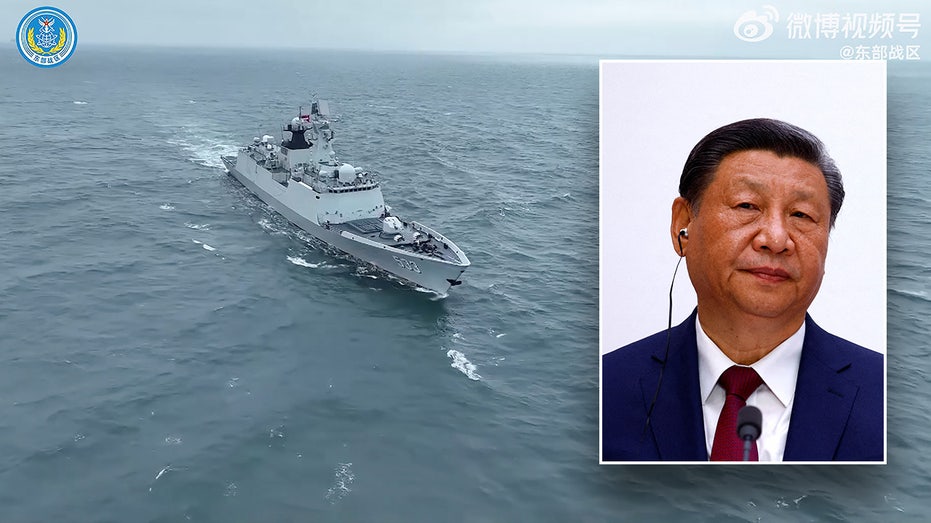An expert claims that China's encirclement of Taiwan was a front for its true objective of persuading the US not to interfere.
The Joint Sword exercises used more military hardware and got closer to Taiwan than ever, but some experts say China’s bigger plan is dissuading the U.S. from even attempting to come to Taiwan’s aid.

Taiwan's Koohsiung China's 13-hour simulated blockade of Taiwan, which started on Monday, October 14, and involved a record-breaking number of planes, an aircraft carrier, and both Navy and Coast Guard vessels, was not exactly about China "punishing" Taiwan's new president William Lai for remarks he has made since taking office in May of this year, despite what much of the international media has reported.
"China planned the exercises in advance and would have carried them out regardless of what Lai said," nonresident senior fellow at the Atlantic Council Global China Hub Elizabeth Freund Larus told Fox News Digital. "The military exercises are intended to wear down Taiwan’s military hardware and personnel. The purposes of the exercises are to threaten Taiwan’s security to the point that the Taiwan people lose confidence in their government and to change the status quo of a Taiwan separate from China."
All those reasons would be enough to justify the military maneuvers if one views them from Beijing’s tactical standpoint, but senior research fellow with the R.O.C. Society for Strategic Studies, Dr. Chang Ching, who also served in the Navy for several decades, told Fox News Digital that people are missing the big picture. Chang pointed to publicly available military logs from Japan that tracked both Russian and Chinese ships over several days before the 13-hour exercise.
A joint staff press release from Japan’s Ministry of Defense on Monday, Oct. 14, stated, "On October 11, 2024 (Friday), around 5 PM, the Japan Maritime Self-Defense Force confirmed the presence of six vessels [four Chinese and two Russian] in the waters approximately 400 km (approx 248 miles) northeast of Okinotorishima Island (Tokyo)." These were just some of the ships identified, and Japanese press releases noted that they had been tracking both Chinese and Russian naval actions since late September.
The location of these ships at those times, Chang asserted, means they cannot have been plausibly connected to the short Taiwan blockade. "The real target is the United States," he told Fox News Digital. "They were using a very old Chinese strategy called ‘encircling the point/striking the reinforcement;’ in other words, practicing ways to ambush the U.S. Navy if it heads towards an already held-hostage Taiwan. If China can convince the U.S. that intervening in any actions it chooses to take in the Taiwan Strait is not worth the risk, then Beijing wins."
Other local experts had similar takes on the situation. Taiwan’s Central News Agency quoted assistant professor at Tamkang University Graduate Institute of International Affairs and Strategic Studies Lin Ying-yu, who argued that the timing of the military drills was an attempt by China to probe the United States’ ability to respond to simultaneous crises on the Korean Peninsula and in the Taiwan Strait.
The Chinese Navy, depending on what matrix is used to measure it, is either in second place after the U.S., has overtaken the U.S., or is basically even. Regardless of rankings, the Chinese have a formidable navy that is often dismissed as inexperienced. Analysts such as Chang, however, who’s spent his adult life studying military strategy and threats, say those who underestimate China’s navy do so at their peril.
China’s fleets boasts many smaller and more modern ships. According to the Center for Strategic & International Studies, about 70% of Chinese warships were launched after 2010, while only about 25% of the U.S. Navy’s were.
Unlike in the past, for Joint Sword 2024B there was no 24-hour prior notification, no specific latitude or longitude parameters were announced, and to add a final touch of menace, no date or time was given for when the exercise was scheduled to end.
Despite this, the general mood on the streets of Taiwan during the encirclement was calm, with almost no one telling the media they felt scared or threatened. Some say such nonchalance is worrying as it implies that the Taiwanese people are beginning to accept that their government and military are powerless to stop China’s incursions that inch closer each time – Joint Sword 2024B, for example, pushed to within 24 nautical miles of Taiwan.
China’s large and well-armed Coast Guard also took part in Joint Sword 2024B. Many Chinese Coast Guard ships are essentially warships, and the fleet includes several 10,000-ton vessels equipped with 76mm guns, and capable of top speeds of 25 knots (28.7 MPH).
In a move Elizabeth Freund Larus described as "rather macabre," and Chang called "a cynical reflection of their ‘abusive relationship’ mindset," an image was released on the official China Coast Guard Weibo account (China’s version of X), depicting a drill route around Taiwan in the shape of a heart. The image featured Chinese characters that translate roughly to "Hello my sweetheart! Our patrol is our way of loving you."
In a recent poll, some 70% of Taiwanese said they expected some type of U.S. help in the event of a Chinese attack, but the U.S. reaction to Joint Sword 2024B was seen by some as being tepid and confusing.
"The United States is seriously concerned by the People’s Liberation Army joint military drills in the Taiwan Strait and around Taiwan," State Department spokesperson Matthew Miller said in a statement. "The PRC response with military provocations to a routine annual speech is unwarranted and risks escalation."
The State Department Asia Pacific Media Hub issued a statement via X on Oct. 15 that read in part, "We have closely monitored the People’s Liberation Army (PLA) exercise, JOINT SWORD 2024B, around Taiwan. This military pressure operation is irresponsible, disproportionate, and destabilizing."
Some in Taiwan are asking why the State Department chose to use the word "disproportionate," as Taiwan has done nothing that would warrant even a "proportionate" response. With just weeks to go before the American presidential election, all official comments coming out of D.C. are likely to be carefully vetted, which makes the State Department’s comments all the more puzzling.
Given that Beijing views nearly everything Taiwan does as "pro-independence provocation," there are calls in Taiwan for the world's democracies, led by the United States, to unite and prepare tangible responses to China's persistent efforts to alter the status quo, militarize the Taiwan Strait, and deny the people of Taiwan their hard-won democracy.
It's "essential for Taiwan to give an update to its National Security Strategy, last revised in 2007, to act as a North star, and to galvanize collective efforts toward peace and stability in the Taiwan Strait," Kitsch Liao, assistant director of the Atlantic Council's Global China Hub, told Fox New Digital.






















